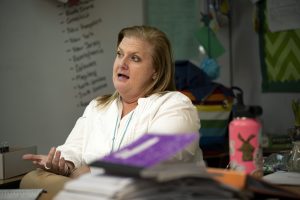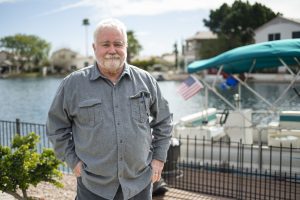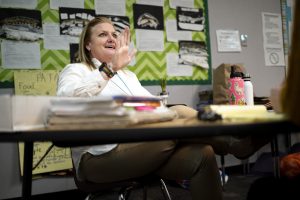EDS: An earlier version of this story misstated information from the Tempe Elementary School District. The district on Feb. 14 filled 87% of its vacancies, and the correct title for Gabrielle Dunton is Assistant Director of Strategic Partnerships and Communication.The story below has been corrected, but clients who used earlier versions are asked to run the correction found here.
- Slug: BC-CNS Substitute Teacher Shortage, 860 words.
- 6 photos and captions below.
By Endia Fontanez
Cronkite News
AVONDALE – When Candie Halberg is called in to substitute teach, she brings a collection of musical instruments, from a recorder to a viola, playing songs as a reward for well-behaved students.
The retired music teacher began subbing, or “guest teaching,” in the Litchfield Elementary and Agua Fria High School districts because she missed working with kids and wanted to be in the classroom a few days a week. But the 69-year-old soon was back to teaching full-time, thanks to a dire statewide shortage of substitutes.
When Halberg opens her list of schools requesting her help each day, there are “at least 20 jobs I can pick from.”
Gregg Sawyer, 69, retired from teaching high school after 46 years and felt much like Halberg.
“I thought, ‘This is a way to get out of my house for a couple days a week,’” he said. “But it’s turned into this craziness. I have to turn my phone off sometimes because principals’ secretaries are calling the house. If they can’t fill it, they’ll call at 8 o’clock and ask if I can be at a school by 9.”
Substitute teaching always has been difficult: moving from school-to-school or grade-to-grade, often with students who think they can have a free-for-all when their teacher is away. But during the pandemic, fears of getting COVID-19 coupled with a deep teacher shortage have added additional stress to the job in Arizona schools.
According to the Arizona School Personnel Administrators Association, as of January, 78% of classrooms in 143 districts surveyed were either without full-time teachers or being taught by people who don’t meet state standards.
The crisis prompted the state Board of Education to relax regulations for subs. In essence, any classroom can be taught long-term by people without college degrees, let alone teaching certificates.
Larena Barnett-Noel, an adjunct professor in the College of Education at Grand Canyon University, said many of her students have been working as emergency substitutes while still completing their teaching degrees.
Sawyer said schools are so desperate he has seen some subs entering schools with walkers and requiring assistance to get to their classrooms.
The teacher shortage existed before the pandemic, with low salaries causing many to leave their jobs and move to other professions. That was happening despite the “Red for Ed” walkouts during the 2017-18 school year, when Gov. Doug Ducey signed into law a 20% raise by 2020.
However, the pandemic drastically exacerbated the shortages. Arizona schools in recent weeks have faced “record breaking” absences, with up to 1,500 teacher vacancies per day during the height of the omicron variant of the virus that causes COVID-19, said Andy Shirk, whose company, Subsource, contracts with school districts for substitutes.
A large number of substitutes, including Halberg and Sawyer, are former teachers. The average age of those employed by Subsource is 56, Shirk said, adding that because his substitutes are at higher risk for COVID-19 complications, 10% to 20% aren’t able to work.
Some, like Sawyer, don’t want long assignments working full time.
School districts scramble daily to fill teacher vacancies. On one day, Feb. 14, the Tempe Elementary School District could fill only 87% of their vacancies, leaving the other rest to be covered by teachers or staff willing to give up their prep time, Gabrielle Dunton, the district’s assistant director of strategic partnerships and communication, said in an email.
“If somebody doesn’t have a substitute,” Halberg said, “all the other teachers have to spend their prep period and chime in and help out with that class. And that happens almost every day that I go to a school, that’s happening somewhere in the school.”
On Jan. 24, the Board of Education passed new regulations to relax the requirements for substitute teachers, including allowing certified substitutes to teach indefinitely. The previous limit was a maximum of 120 days per school.
It also relaxed certification for emergency substitutes, who need no more than a high school degree or GED if a school is suffering a severe shortage. In the past, subs had to renew their certificates every year; now it’s every two years.
“It’s a small step, but a very important step,” Shirk said of the new regulations. He said he hopes that with the extra leniency, more people will be able to step up into emergency substitute positions for longer periods of time, and that districts will have “a lot less headaches.”
Barnett-Noel at GCU doesn’t agree.
“It kind of stresses me out because they (substitute teachers) don’t have all the tools yet,” she said. “And they’re offering jobs to people who just have a degree in anything. That kind of worries me, too. Because just because you know everything about math doesn’t mean you’re a teacher.”
But with the shortage, there are some advantages.
Barnett-Noel, 48, said after teaching for 20 years, she decided to stay home when her daughters were born. But she took up substitute teaching a few years ago to make extra money because the pay rates for subs have increased with the shortage. In north-central Phoenix’s Madison School District, she said, daily pay rates have risen about 18% in the last three years.
“They couldn’t get anybody,” she said. “They were so happy to have me.”
For more stories from Cronkite News, visit cronkitenews.azpbs.org.
^__=





